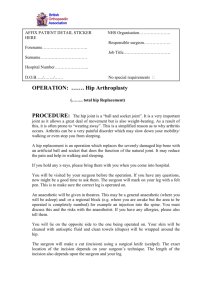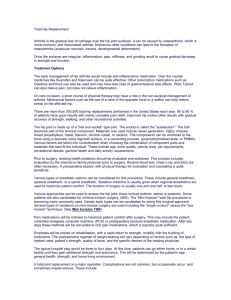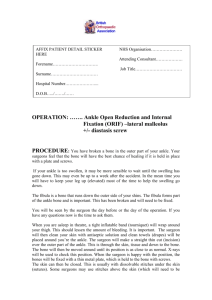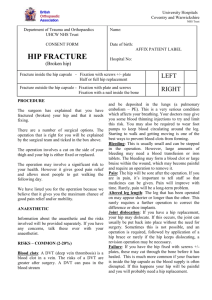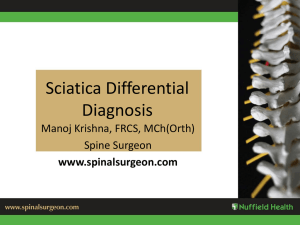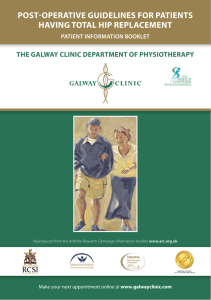DHS - Dynamic (Sliding) Hip Screw
advertisement
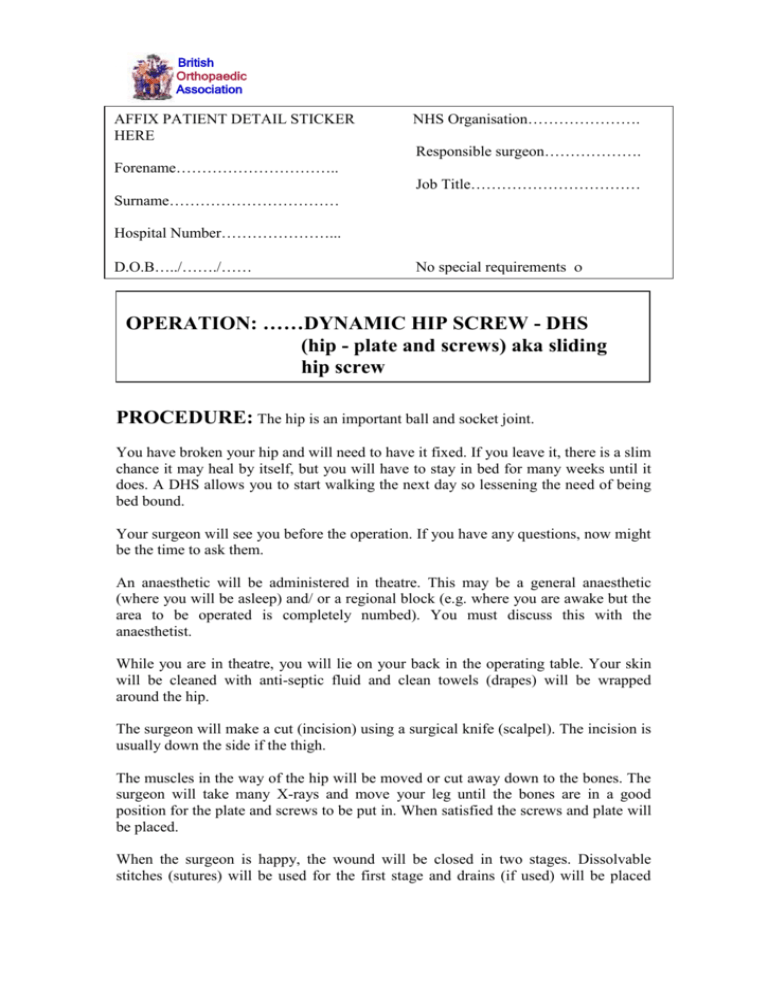
British Orthopaedic Association AFFIX PATIENT DETAIL STICKER HERE NHS Organisation…………………. Responsible surgeon………………. Forename………………………….. Job Title…………………………… Surname…………………………… Hospital Number…………………... D.O.B…../……./…… No special requirements OPERATION: ……DYNAMIC HIP SCREW - DHS (hip - plate and screws) aka sliding hip screw PROCEDURE: The hip is an important ball and socket joint. You have broken your hip and will need to have it fixed. If you leave it, there is a slim chance it may heal by itself, but you will have to stay in bed for many weeks until it does. A DHS allows you to start walking the next day so lessening the need of being bed bound. Your surgeon will see you before the operation. If you have any questions, now might be the time to ask them. An anaesthetic will be administered in theatre. This may be a general anaesthetic (where you will be asleep) and/ or a regional block (e.g. where you are awake but the area to be operated is completely numbed). You must discuss this with the anaesthetist. While you are in theatre, you will lie on your back in the operating table. Your skin will be cleaned with anti-septic fluid and clean towels (drapes) will be wrapped around the hip. The surgeon will make a cut (incision) using a surgical knife (scalpel). The incision is usually down the side if the thigh. The muscles in the way of the hip will be moved or cut away down to the bones. The surgeon will take many X-rays and move your leg until the bones are in a good position for the plate and screws to be put in. When satisfied the screws and plate will be placed. When the surgeon is happy, the wound will be closed in two stages. Dissolvable stitches (sutures) will be used for the first stage and drains (if used) will be placed British Orthopaedic Association now. Any drains can be easily and relatively painlessly removed in the next couple of days on the ward. The skin can finally be closed. Some surgeons use stitches, while others prefer metal clips (skin staples). Both methods are equally successful and come down to surgeon preference. When you wake up, you will fell sore around the hip, this is normal. You will be encouraged to start walking as soon as possible with the aid of the physiotherapists. You may be encouraged to put full weight through the leg or to put only a little through. An X-ray and a blood test may be taken the next day. ***Please be aware that a surgeon other than the consultant, but with adequate training or supervision may perform the operation** ALTERNATIVE PROCEDURE: When an important bone has been broken and you can not walk, you will be at great risk of developing complications. These include blood clots (see below) and serious lung infections. These are life threatening and mean we strongly recommend an operation. Sometimes you may stay in bed until the bone heals but this can take months (healing is not guaranteed). There may other types of operation available to fix the bone. These include screws alone or a hip replacement. Not all operations are appropriate in your case. RISKS As with all procedures, this carries some risks and complications. COMMON: (2-5%) Blood clots: a DVT (deep vein thrombosis) is a blood clot in a vein. These may present as red, painful and swollen legs (usually). The risks of developing a DVT are greater after any surgery (and especially bone surgery). Although not a problem themselves, a DVT can pass in the blood stream and be deposited in the lungs (a pulmonary embolism – PE). This is a very serious condition which affects your breathing. Your surgeon may give you medication through a needle to try and limit this risk of DVTs from forming. Some centres will also ask you to wear stockings on your legs, while others may use foot pumps to keep blood circulating around the leg. Starting to walk and getting moving is one of the best ways to prevent blood clots from forming. Bleeding: this is usually small and can be stopped in the operation. However, large amounts of bleeding may need a blood transfusion or iron tablets. Rarely, the bleeding may form a blood clot or large bruise around the wound which may become painful require an operation to remove it. Pain: the hip will be sore after the operation. If you are in pain, it is important to tell staff so that medicines can be given. Pain will British Orthopaedic Association improve with time. Rarely, pain will be a chronic problem. This may be due to altered leg length or any of the other complications listed below, or sometimes, for no obvious reason. LESS COMMON: (1-2%) Infection: You will be given antibiotics just before and after the operation and the procedure will also be performed in sterile conditions (theatre) with sterile equipment. Despite this there are still infections (1 to 2½%). The wound site may become red, hot and painful. There may also be a discharge of fluid or pus. This is usually treated with antibiotics, but an operation to washout the joint may be necessary. In rare cases, the prostheses may be removed and replaced at a later date. The infection can sometimes lead to sepsis (blood infection) and strong antibiotics are required. Catheterisation: if you have difficulty in passing urine immediately after the operation, the team may pass a tube into the bladder. This is usually temporary. Catheterisation may be done before the operation. Altered leg length: the leg which has been operated upon, may appear shorter or longer than the other. This may require a further operation to correct the difference or physiotherapy. RARE: (<1%) AVN: This is a loss of blood to the top of the thigh bone. If this happens, the head of the thigh bone becomes weak. This may need replacement with a hip replacement. This is another operation. Altered wound healing: the wound may become red, thickened and painful (keloid scar) especially in Afro-Caribbean. Hip stiffness: may occur after the operation, especially if movement post-operation is limited. Manipulation of the joint (under general anaesthetic) may be necessary. Nerve Damage: efforts are made to prevent this, however damage to the small nerves around the hip is a risk. This may cause temporary or permanent altered sensation around the hip. There may also be damage to the sciatic Nerve, this may cause temporary or permanent weakness or altered sensation of the leg. Bone Damage: the thigh bone may be broken when the prosthesis (false joint) is inserted. This may require fixation, either at time or at a later operation. Blood vessel damage: the vessels around the hip may rarely be damaged. This may require further surgery by the vascular surgeons. DEATH: a broken hip is a very serious condition. Getting up and about as soon as possible is one of the best ways to prevent many of the above. British Orthopaedic Association If you have any complaints about your treatment or your care, you are always encouraged to discuss them with your surgical team. However, if you wish to complain to the trust, each hospital will have a PALS or Patient Advise and Liaison Service. The head nurse on the ward or out patients’ clinic can direct you to them. The PALS team will treat all complaints seriously. I have read/ understand the procedure, risks and complications. I have asked any questions and raised any immediate concerns I might have. I understand another surgeon other than my consultant may perform the operation.(although they will have adequate training/ supervision). I understand that I will have the opportunity to discuss the details of anaesthesia with an anaesthetist before the procedure I understand that any procedure in addition to those described on this form will only be carried out if it is necessary to save my life or to prevent serious harm to my health Signature…………………………………………………. Print name……………………………………………………….... Date………./…/20… 2nd Confirmation………………...............…… .Date…………./…..20… I also give consent for my notes and data to be used in any studies and trials in the future I also give consent for any bone (discarded) to be sent to the bone bank – this may be then offered to other patients who require bone grafting) SIGNATURE ……………………………………………. DATE …./…./20 PRINT NAME…………………………………………… NAME of SURGEON (Capital letters)……………………………….. NAME of SURGEON (Capital letters)……………………………….. SIGNATURE of SURGEON…………………………………………. SIGNATURE of SURGEON…………………………………………. POSITION…………………………………………………………….. POSITION…………………………………………………………….. DATE……./………/20……
